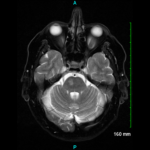Moreover, MTX reduced patients’ need for corticosteroids. At 48 weeks, those treated with MTX had taken an average of 842 mg less of corticosteroids than those who were treated with placebo.
The researchers speculate that the initial discrepancies among the three studies arose because of differences in the length of follow-up. The benefit of MTX only appears after 24 to 36 weeks of treatment.
Though the study supports the use of MTX as adjunctive therapy in patients with new-onset GCA, Dr. Merkel emphasizes that corticosteroids must remain “the first and most important therapy. We don’t want a single doctor to think MTX should replace them.”
Psoriatic Arthritis Patients Without Classic Atherosclerosis Risk Factors Often Have Subclinical Disease
Psoriatic arthritis (PsA) patients have an increased risk of experiencing adverse cardiovascular events, according to a study published in Arthritis Care & Research (2007;57:1074-1080).
Several previous studies have asked whether patients with PsA – like patients with RA – have an increased risk of developing cardiovascular disease and thus have a higher mortality rate than the general population. But the results of these studies differed: some found a correlation and others did not.
To answer the question more definitively, a group of Spanish researchers used non-invasive ultrasonography to determine the intima-media thickness (IMT) of the carotid arteries and the presence of carotid plaques in 59 PsA patients and 59 matched control subjects. They found that PsA patients had significantly larger IMTs than matched controls. Though plaques were more often found in the PsA patients than the controls (nine and three patients, respectively), the difference was not statistically significant.
Because the IMT of the carotid arteries directly correlates with the risk of experiencing adverse cardiovascular events, the authors of the new study say these results show that PsA patients – even those without traditional risk factors – are at greater risk of cardiovascular disease.
The study confirms for the first time “that psoriatic arthritis by itself, regardless of other factors, is associated with accelerated atherosclerosis,” says lead author Miguel A. Gonzalez-Gay, MD, PhD, of the rheumatology department at the Hospital Xeral-Calde in Lugo, Spain. He was not especially surprised by these results, as they agreed with some epidemiological data reported by Canadian researchers.
Dr. Gonzalez-Gay recommends that, like RA patients, all PsA patients receive an ultrasound to determine IMT thickness. “The technique is cheap and rapid,” he says.
Moreover, he stresses that doctors should prescribe statins to PsA patients in order to keep their LDL-cholesterol levels low. As with patients who have diabetes or coronary artery disease, he says, PsA patients should ideally maintain LDL-cholesterol levels of about 100 mg/dl, which is lower than the 140-160 mg/dl that is normal in patients who are not at risk.

